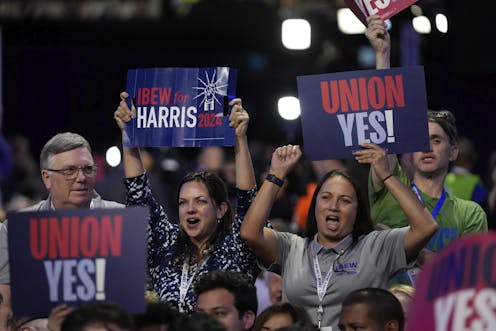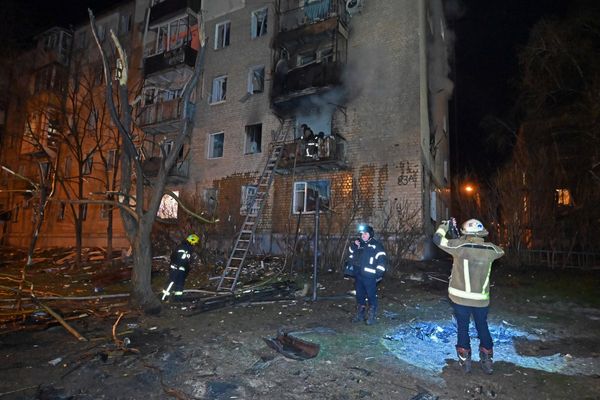
I wonder what my dad, a butcher and a die-hard union man, would think about the state of our country’s political affairs. Is it “Morning in America” as Ronald Reagan exclaimed? “American Carnage” as Donald Trump proclaimed? Or, do “we have nothing to fear but fear itself,” as Franklin D. Roosevelt put it?
Unions in the automotive, steel, rubber and other industries played a powerful role in FDR’s 1936 reelection. According to a poster made during his administration, Roosevelt said, “If I went to work in a factory, the first thing I’d do would be to join a union.” Whether he meant it or not, as a labor historian I’ve long observed that the Democratic Party and unions stuck together back then like peanut butter and jelly.
Unions gave their preferred political party their votes, money and time – by volunteering to hold signs on Election Day, door-knock for candidates, and staff telephone banks to call prospective voters. And Democrats pushed policies that organized labor championed, like establishing a minimum wage, creating the Social Security system and introducing the federal oversight of union elections.
‘That’s what unions do’
My dad, Albert Forrant Jr., benefited from and participated in this coalition. He planted trees in the Civilian Conservation Corps, a New Deal program for young people to provide employment and a small wage during the late 1930s. After my Dad returned from fighting in World War II, he and my mom purchased the single-family home I grew up in, with a mortgage the federal government backstopped. Thereafter, he worked for 40 years as a meatcutter for a large grocery chain.
Dad often took me to Amalgamated Meat Cutters and Butcher Workmen of North America union meetings, sometimes talking about the importance of sticking together on the car ride.
“That’s what unions do,” he informed me. “We help each other.”
Both sides took this marriage for granted until Southern Democrats, concerned that labor unions would organize Black workers across the South, joined their pro-business Republican colleagues in Congress and pushed back against pro-labor legislation. That led to the passage of the Taft-Hartley Act in 1947. The law curtailed union spending on elections, limited the effectiveness of strikes and tightened organizing rules.
Eventually, union membership declined, further disrupting the relationship. Fewer union households meant less influence, especially in states like Wisconsin, Michigan and Pennsylvania that had been the stomping grounds of powerful unions. Today, only 1 in 10 U.S. workers belong to a union.
Jumbled politics
The practical political lessons were lost on me when I was young.
Later in life, I worked at a metalworking factory in western Massachusetts and the light switched on. I started as a machinist and then became my union’s business agent. Many of the 1,000 workers at the factory reminded me of my father: hardworking, focused on supporting their families, scrupulously fair and reliant on their paycheck to make ends meet. Their lives exemplified the quiet dignity found in hard work.
If my dad were alive today, I believe he would find it hard to fathom that nearly half of union members in some occupations have supported Republican presidential candidates during recent elections. An important voting bloc, unions do not necessarily vote solely based on economic self-interest, nor do they simply vote the way their union leadership suggests. In other words, taking the labor vote for granted is a failed position.
So, why is it that many working people have their politics so jumbled?
I think about this question a lot, especially when Americans are getting ready to vote in an important election.
Predicting Trump’s victory in 2016
One week before the 2016 presidential election, I told the students in my labor history class I was fairly certain that Trump would win that presidential race, and I gave them two reasons.
First, a former student of mine was doing advance work in Michigan for Hillary Clinton. She contacted me to express her concerns about the scant efforts made in the Upper Midwest to organize union households to vote for the Democratic Party’s presidential nominee in that key swing state.
Second, a week before the election, I chaired a discussion in Greenfield, Massachusetts – a metalworking town in a once robust metalworking region. With me were three former machinists, and they were feeling angry and let down. Without a decent job in over two decades, they were thirsting for almost any kind of change and seemed willing to bet on Trump.
I believe that this anxiousness is a big reason why blue-collar areas around the Great Lakes and in other parts of the country became seedbeds for the Republican presidential victory in 2016, the GOP’s near-win in 2020 and Trump’s possible second election in 2024.
Dinner table anxiety
As the U.S. economy changed in the late 20th century, millions of manufacturing jobs disappeared. In my view, the Democratic Party still did better by working families than Reagan, George H.W. Bush and George W. Bush, or Trump.
But ties between Democrats and working-class voters had frayed, partly because by the early 1990s most Democratic leaders seemed to have forgotten the party’s historical ties to organized labor.
President Bill Clinton was in office as the downsizing of the industrial heartland befell many unionized workers.
The North American Free Trade Agreement he had advocated for and signed into law in late 1993 shook up labor markets. Economists differ on how many jobs disappeared. The Congressional Research Service concluded that fewer jobs were created and fewer jobs were lost than were predicted by proponents and opponents of the measure. The U.S. Bureau of Labor Statistics found that more than 4 million U.S. manufacturing jobs were lost overall from when NAFTA and similar free trade agreements took effect and 2010.
The number of those jobs has since rebounded slightly.
Economists and other scholars disagree about the role that automation and other kinds of technology played in this job displacement.
Biden’s legacy: Union halls activated
Rhetorically, Democrats too often talked about how the middle class built America. Pipe fitters, heavy equipment operators and hotel workers, autoworkers and steelworkers did not see themselves in that picture. People like my dad and the metalworkers I worked with built the country and powered the economy that created the middle-class generational prosperity that many Americans enjoy to this day.
The Democratic Party’s platform, awkwardly worded for my money, now makes the point that “Democrats know that Wall Street didn’t build America. The middle class built America – and unions built the middle class.”
Joe Biden is the first president to walk a picket line, though for this labor historian and many others, FDR’s New Deal remains the gold standard for advancing labor’s cause.
But it’s clear that the Biden administration fought for laws giving everyone the right to organize for better pay, benefits and working conditions, advancing the bargaining rights of public sector workers and guaranteeing a right to organize for domestic workers, farmworkers and other unprotected laborers. And now the Harris-Walz ticket will keep fighting for that agenda.
For its part, the Republican Party dedicated its 2024 political platform “to the Forgotten Men and Women of America.” However, there is very little concrete support for workers’ rights to organize spelled out in that document.
In a show of strength, Liz Shuler, president of the AFL-CIO – the biggest federation of U.S. unions – and six more of the nation’s most influential union leaders addressed the Democratic National Convention on its opening night.
By comparison, only Sean O'Brien, head of the Teamsters Union, spoke at the Republican National Convention that nominated Trump for a third time.
One thing seems certain: Democrats in 2024, unlike in 2016, understand that their road to victory requires making many stops at union halls.
Robert Forrant is a member of the Massachusetts Association of University Professors. From 1974 - 1988, he was a member of the International Union of Electrical Workers Local 206 in Springfield, MA.
This article was originally published on The Conversation. Read the original article.







